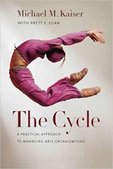 J. MacGuire in clearly one of the finest soliloquies of our time. J. MacGuire in clearly one of the finest soliloquies of our time. That blur that just went by was January. Does 2024 feel any different than 2023 for your #BoardGoals? Even a hint? If the energy just isn't there, you need a fresh approach to summon it -- before you blink and it's August. The almost universal commentary that I hear about my clients' boards sounds like: "Honestly, it's stuck in 2nd gear and I don't know what we need to get us really moving. It's frustrating." The answer isn't another group strategy you announce at a meeting and nearly everyone lets slide through spring. It's individual-level planning and accountability. Like the pleas of Jerry MacGuire, help them help you. Did you know that individual Board member action plans are a thing? Here's the cheat code: 1. You share a 3-page checklist of gloriously useful Board-level tasks and ideas with each member -- which you can customize for your org. Available on this site for the price of a lunch out. 2. They privately mull over their capacity, time, and highest needs of your nonprofit looking an entire 12 months ahead. 3. They decide what they can do and when, document it in their plan, and share it with you. 4. Voila. Clarity for all parties. Meet with those who want to talk things over. Welcome their new ideas and margin notes. These are eminently fruitful conversations in my experience. And because each Board member planned specific, timed actions themselves -- these things tend to get DONE! Then make it an annual ritual.
1 Comment
Concern #1: Donors might shift their focus to health-related projects.
Your Best Response: Your donor communications should explain how your organization is responding to the situation. Include details about what you’re doing to help protect the well-being of stakeholders at your organization that your donors care most about.
Your Best Response: State upfront that your organization puts your community’s health and well-being first. Then make the appeal that support now is more important than ever to ensure your organization is in a strong place when this lifts to get back to creating joy and great art. Think about ways you might use digital events to engage your donors. A performance might not make sense, but what about a conversation with your artistic staff about how a project is developing? Could you do a virtual script reading? Concern #3: Corporate giving is the first to contract in a down market. Corporate donors should be a low priority now for solicitations. Put the top priority on family foundations and individuals. They’re most likely to take the long view on the markets and have some cushion. Reach out to the business partners and sponsors who you have very close, long-running relationships with. Otherwise, most corporate/business contacts will need time to see how they're impacted. Concern #4: Older donors are totally self-isolated. For major gift plans long in the works with individual donors, ask for the meeting when your campaign is ready, but start out by asking how they're doing first and listen. It's possible they might be willing to do a video call for a request if you've cultivated them well and recently -- and if they signaled that they were ready in the past several weeks to be asked for a big project. Be prepared if they say they need to wait a month or two for the meeting and be diligent about follow-ups. Isolation means many major donors likely welcome your update call or email. Everyone is answering their phones right now. Reach out to your top priorities to keep the relationship warm and keep them updated on how you're managing through this. Concern #5: It’s uncertain how long this will affect daily life. Develop contingency plans for the efforts that really matter. Your board should have an emergency meeting if it hasn't already to plan 2-3 different scenarios. One of those should anticipate a six-month recession. How much capital do you have to get through the next months without new revenue? What can you do to stretch what you do have? Can you create new revenue streams with digital content? Are there any major restricted grants or gifts that you can talk to the donors about, asking them to loosen restrictions right now? How much would your fundraising team need to raise exactly to fill the gaps? By when? What if the fall appeal is impacted? They can't fundraise without goals and a clear picture. Larger donors will want to know. Remember that since 1980, the US has been through five official recessions. Donors have continued to give through all of them, but with more focus on the organizations that earn their love and trust. We still saw growth in giving over those periods – but it was slower. Concern #6: We don’t know where to cut the operating budget if we need to. The last place to cut is where you’re still generating revenue. A strong fundraising effort needs to stay in place no matter what. Meet with your board, make sure they understand that their focus and collaboration are critical to help keep your fundraising programs strong to weather this. Can they call lapsed donors at the higher levels and ask for a renewal? Can they assist in nudging donors thinking about bigger requests? This is the time to make sure that the organization's leaders pull together.  About a year ago, a colleague recommended that I look into The Cycle, Michael Kaiser's management method for running high-performing arts organizations. At the time, I was just starting up my practice and needed to focus on other things, so I put a mental pin in it. This spring, after finishing up a house renovation and moving in, I was hungry to focus on some meaty professional development while *not* thinking about the miles of trim that I have yet to paint. I was DELIGHTED to see that The Cycle isn't just a book now -- it's a free online course on Coursera. And WOW. It's excellent work well worth the time to watch the lectures, if not complete all the exercises. Who's Michael Kaiser? He's the executive director that brought Alvin Ailey American Dance Theater back from the brink. And then he ran the Kennedy Center for the Performing Arts in Washington, DC, for about 13 years. He started a management institute there, honing this method of focusing tightly on making great art (the easy part!), marketing institutionally, and building relationships with what he calls the "family." Guess which part is my favorite? As Kaiser acknowledges, the lessons apply to all sorts of organizations beyond arts and culture - that just happens to be his bailiwick. The institute how lives at the University of Maryland, and has expanded its scope. I can't say enough about the quality of this course. And hooray for free! www.coursera.org/learn/the-cycle  An article in Albuquerque Business First today touts the use of LinkedIn as a free, easy relationship mapping tool to prospect for major gifts. While it’s not the worst fundraising advice I’ve ever heard (in a category of journalism that can often range from the tone deaf to the truly misleading), it is flawed. Here are a few reasons why you shouldn’t over-rely on LinkedIn for this task, especially for gifts that trustees will solicit:
So my advice – whether you have a consultant or are doing this solo – is that the quickest, most effective method is still a largely human-centered one:
 One more place in life to cultivate balance. Namaste. One more place in life to cultivate balance. Namaste. Board work is one of the most rewarding things about nonprofit development. No matter what your structure, it’s absolutely where you learn all of the big leadership lessons for your organization, and in my opinion it’s the engine that either gives it vitality - or not. Vitality is about balancing all the right elements and getting them to play well together. Here are the five profiles of people that I think you absolutely need on your board – plus a rare one that’s a huge find.
|
AuthorEmilie, Principal and Owner Archives
February 2024
Categories
All
|
 RSS Feed
RSS Feed